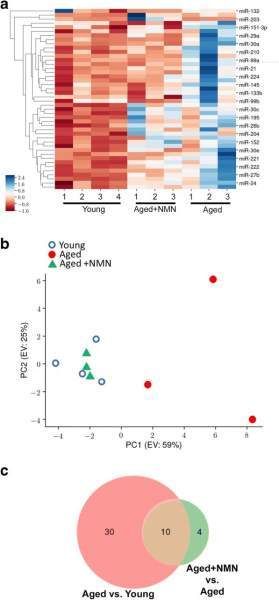There is increasing evidence showing that a decrease in NAD + availability with age plays a critical role in age-related neurovascular and cerebromicrovascular dysfunction. Our recent studies demonstrate that restoring cellular NAD+ levels in aged mice rescues neurovascular function, increases cerebral blood flow, and improves performance on cognitive tasks.
Understanding molecular mechanisms involved in vascular aging is essential to develop novel interventional strategies for treatment and prevention of age-related vascular pathologies.
Aging-induced structural and functional alterations of the neurovascular unit lead to impairment of neurovascular coupling responses, dysregulation of cerebral blood flow, and increased neuroinflammation, all of which contribute importantly to the pathogenesis of age-related vascular cognitive impairment (VCI).
Importantly, in aged mice, restoration of cellular NAD+ levels by treatment with the NAD+ booster nicotinamide mononucleotide (NMN) exerts significant vasoprotective effects, improving endothelium-dependent vasodilation, attenuating oxidative stress, and rescuing age-related changes in gene expression.
We refer to two recent studies, references below.
To determine the effects of restoring cellular NAD levels on neurovascular gene expression profiles, 24-month-old C57BL/6 mice were treated with nicotinamide mononucleotide (NMN), a key NAD+ intermediate, for 2 weeks.
Transcriptome analysis of preparations enriched for cells of the neurovascular unit was performed by RNA-seq. Neurovascular gene expression signatures in NMN-treated aged mice were compared with those in untreated young and aged control mice. We identified 590 genes differentially expressed in the aged neurovascular unit, 204 of which are restored toward youthful expression levels by NMN treatment.
The transcriptional footprint of NMN treatment indicates that increased NAD+ levels promote SIRT1 activation in the neurovascular unit, as demonstrated by analysis of upstream regulators of differentially expressed genes as well as analysis of the expression of known SIRT1dependent genes.
Pathway analysis predicts that neurovascular protective effects of NMN are mediated by the induction of genes involved in mitochondrial rejuvenation, anti-inflammatory, and anti-apoptotic pathways.
In conclusion, the recently demonstrated protective effects of NMN treatment on neurovascular function can be attributed to multifaceted sirtuin-mediated anti-aging changes in the neurovascular transcriptome.
Our present findings taken together with the results of recent studies using mitochondria-targeted interventions suggest that mitochondrial rejuvenation is a critical mechanism to restore neurovascular health and improve cerebral blood flow in aging.
Strong experimental evidence shows that dysregulation of microRNAs (miRNAs) has a role in vascular aging. The present study was designed to test the hypothesis that age-related NAD+ depletion is causally linked to dysregulation of vascular miRNA expression. A corollary hypothesis is that functional vascular rejuvenation in NMN-treated aged mice is also associated with restoration of a youthful vascular miRNA expression profile.
To test these hypotheses, aged (24-month-old) mice were treated with NMN for 2 weeks and miRNA signatures in the aortas were compared to those in aortas obtained from untreated young and aged control mice. We found that protective effects of NMN treatment on vascular function are associated with antiaging changes in the miRNA expression profile in the aged mouse aorta. The predicted regulatory effects of NMN induced differentially expressed miRNAs in aged vessels include anti-atherogenic (atherogenic means formation of fatty deposits in the arteries) effects and epigenetic rejuvenation.

Nmn Supplementation Aging 2019
Future studies will uncover the mechanistic role of miRNA gene expression regulatory networks in the antiaging effects of NAD+ booster treatments and determine the links between miRNAs regulated by NMN and sirtuin activators and miRNAs known to act in the conserved pathways of aging and major aging-related vascular diseases.
References:-
https://pubmed.ncbi.nlm.nih.gov/32056076/
https://www.ncbi.nlm.nih.gov/pmc/articles/PMC6815288/pdf/11357_2019_Article_95.pdf